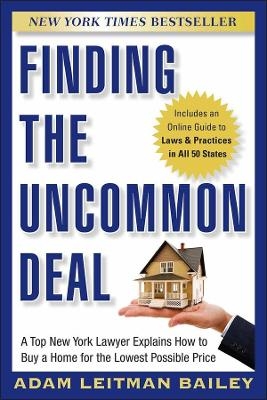
Finding the Uncommon Deal
John Wiley & Sons Inc (Verlag)
978-0-470-94366-3 (ISBN)
- Lieferbar (Termin unbekannt)
- Portofrei ab CHF 40
- Auch auf Rechnung
- Artikel merken
Take advantage of today's real estate market to find great properties at incredible prices
Our recent economic meltdown transformed real estate from a popular investment to financial kryptonite. Too many people purchased homes with mortgages they simply could never afford. The good news: Great deals are out there for the taking. Finding the Uncommon Deal gives you the secrets to discovering and successfully negotiating the lowest prices for the most prized properties available.
Discover how to go beyond Internet listings to get on-the-ground intelligence on the best deals
Get proven negotiating skills to close the deal at a rock-bottom price
The author has assisted thousands in purchasing homes as a lawyer, broker, and investor; has been ranked by internationally esteemed publication Chambers and Partners as one of the leading real estate lawyers; and regularly appears as a real estate authority in the New York Times and the Wall Street Journal
If you're successful enough to afford a home, then you probably have the skills needed to get a great deal in today's market. Finding the Uncommon Deal gives you the keys to leverage your skills for success and savings, opening the door to today's best properties and lowest prices.
ADAM LEITMAN BAILEY, ESQ., has assisted thousands of property owners in buying homes. He owns one of the nation’s most prominent real estate law firms as well as a real estate brokerage company and investment properties. The esteemed Chambers & Partners publication has selected him as one of New York’s Lead-ing Real Estate Lawyers, and he was named a Super Lawyer by Law & Politics magazine.
Foreword Evan Farmer xiii
Preface: Greed, Fear, and Opportunity in the New Real Estate Environment xvii
Introduction: Should You Buy or Rent? 1
The Greatest Producer of Wealth for American Families 1
The United States Government Encourages Homeownership 3
The Pride of Having a Place to Call Your Own 3
The Time to Buy 4
The Cost of Buying and Maintaining a Home 5
Building Equity 6
The Case for Renting 6
Part I Finance: Do Not Go Shopping Until You Know How Much Money You Have to Spend 13
1 Get Ready to Buy: Tools and Suggestions to Maximize Buying and Borrowing Power 15
Make a List of Your Assets and Liabilities 15
Creating a Budget and Living within Your Means 17
The Down Payment and Private Mortgage Insurance 21
Obtaining a Credit Report 23
FICO Score 24
2 How to Get the Cheapest Loan at the Best Rate 27
How Banks Make Money by Giving You a Loan 27
What Is a Mortgage? 28
Obtaining the Loan: Learning the Bank’s Requirements 29
The Mortgage Broker 30
Getting the Best Loan: Fitting the Loan into Your Plans and Financial Means 30
The New Good Faith Estimate: Keeping the Lender Honest 30
Choosing the Most Appropriate Inexpensive Loan 31
Annual Percentage Rate (APR) 32
Tax Deductions and the Interest Rate on Your Mortgage 32
Paying Points 33
The Amount of the Loan 35
Documents Required to Obtain a Loan 35
The Different Types of Loans 35
The Loan Process 41
The Financing Process 42
3 Buying a Home with Little or No Money Down and Obtaining Seller Financing 49
Putting Little or No Money Down 50
Part II Finding the Uncommon Deal on a Home 57
4 Becoming an Expert on Finding the Dream Home 59
The Real Estate Broker 60
Finding a Property to Purchase: Various Choices and Forms of Shelter 60
Making the Decision 68
5 Conducting the Search: Finding Your Allies in the Real Estate Hunt 71
Insider Trading—The Legal Way 71
Making Friends in Strange Places 72
Location, Location, Location 72
Determining Fixed Monthly and Yearly Housing Costs 73
Making a Wish List 74
Real Estate Brokers: The Guardians of Real Estate 75
Maximizing the Success of the Search 79
6 The Secret to Buying a Distressed Property 83
The DNA of a Deal Finder 83
Distressed Homes: The Most Common Uncommon Deals 84
Finding the Uncommon Deals Using the Most Common Means 84
Becoming a Proactive Deal Hunter 85
7 Pre-Foreclosures and Short Sales 89
Finding a Pre-Foreclosure 89
The Foreclosure Filing 90
Buying a Short Sale 92
Learning More About the Distressed Property 94
Making Contact with a Distressed Owner 95
8 Foreclosures and Bank-Owned Properties 103
Finding a Foreclosure Sale 103
Buying a Foreclosed Property 104
Attending the Foreclosure Auction 104
Determining How Much Money to Bring to the Auction 105
Foreclosure Pitfalls: Taking the Property As Is and Evicting the Occupants 105
Losing the Property to Redemption Laws 105
Financing the Purchase 105
REO/Bank-Owned Properties 106
9 Hidden Land Mines to Look Out for 111
Determine Whether the Home Is Legally Habitable 111
Be Aware of the Number of Units Sold and Occupied in Newly Constructed Apartment Developments 112
Clear All Liens and Obtain Signoffs for Extensions and Alterations before Closing on a Home 113
Inspecting for and Understanding the Underground Oil Tank 113
Buying a Home with Occupants or Tenants in Possession 114
Purchasing a Land Lease in a Cooperative Apartment: Determine Whether You Are Buying or Renting the Land 115
Property Taxes Can Change 116
Different Ways to Take Title to the Home 116
10 Creative Ways to Get the Seller to Accept Your Below-Market Offer 121
Offer All Cash or Do Not Make the Deal Contingent on Obtaining a Loan 121
Know How to Play the Negotiation Game: Making and Responding to the Counter Offer 122
Get the First Call When the Price Drops: Give Sellers Your Price and Ask Them to Call You When the Asking Price Falls 123
Become the Real Estate Broker’s Best Friend 123
Bring Your Financial Resume to Demonstrate Your Ability to Close on the Home 124
The Right of First Refusal 124
Buyer Flexibility: Learn the Seller’s Moving Preferences 125
Endear the Seller through Thoughtful Gestures and Remembering Names and Life Events 125
Place an Ad or Create a Web Site or Commercial 126
11 Negotiating a Great Deal on a Newly Constructed Property: What You Must Know Before Signing the Contract to Purchase 129
Conduct an Extensive Inspection of the Premises Using a Qualified Inspector/Engineer 130
Know the Builder’s Past Performances 131
Obtain Warranties from the Builder 131
The Brand Names and the Appliances and Fixtures Installed Should Be Itemized in the Contract of Sale 132
The Most Common Problem When Purchasing a New Construction: The Move-In Date 132
Locking In an Interest Rate 133
Part III Getting Uncommon Deals on Closing Costs 139
12 The Closing Map: A Guide to Finding and Buying a Home 141
Obtaining Financing 141
Making the Offer 142
Hiring an Attorney 143
The Acceptance of the Offer and Drafting of the Contract of Sale 143
Signing the Contract of Sale and Making the Contract Deposit 144
Insurance and Tax Escrow 145
The Mortgage Contingency Clause and Other Contingencies 145
The Closing Date 146
The Engineer 147
Due Diligence for Cooperative and Condominium Purchases 147
Reviewing the Building’s Financials 147
Termite Inspection 148
Board Applications 149
Title Insurance and Lien Search 149
The Board Interview 150
Obtaining the Right of Possession of the Home 150
The Closing 151
13 Using the Home Inspection to Lower the Price 155
The Inspection 156
Finding the Right Home Inspector 158
Protecting Yourself When Signing the Contract of Sale 160
14 Finding, Hiring, and Utilizing an Aggressive Attorney 163
Whether to Hire an Attorney 164
Finding an Attorney 164
The Mini-Interview 165
Questions for the Attorney Candidate(s) 165
When to Consult an Attorney 166
The Functions of the Purchaser’s Attorney 167
The Makings of a Good Real Estate Attorney 170
15 The Walk Through: The Final Inspection 173
The Walk Through as an Inspection 173
The Punch List 174
Let the Buyer Beware 174
16 The Importance of Homeowner’s Insurance: Acquiring the Knowledge to Purchase and Maintain a Sufficient Policy for Your Home or Investment Property 179
The Homeowner’s Insurance Policy 180
The Function of the Homeowner’s Insurance Policy 180
Ways to Reduce the Cost of Homeowner’s Insurance 181
Maintaining a Homeowner’s Insurance Policy 182
Insurance through the Federal Government 183
Homeowner’s Insurance in Cooperatives and Condominiums 183
Obtain References 184
What You Should Know Before Making a Claim 184
17 The Purchase of Title Insurance 189
What Is Title Insurance? 189
Who Pays for Title Insurance? 190
Why an Owner’s Policy Should Always Be Purchased 191
The Function of a Title Insurance Company 191
The Cost of Title Insurance 192
Examples of When Title Insurance Becomes Important 192
Title Insurance and Purchasing a Cooperative Apartment 194
The Abstract 194
18 Closing Cost Guide: Determining the Complete Cost of Selling or Purchasing a Property 199
Customary Purchaser Closing Costs 200
Purchaser Closing Costs Unique to Cooperatives and Condominiums 205
Closing Cost Example: New York Customary Purchaser Closing Costs 206
Customary Seller Closing Costs 208
Conclusion 221
Acknowledgments 223
Index 225
| Zusatzinfo | Charts: 13 B&W, 0 Color; Graphs: 1 B&W, 0 Color |
|---|---|
| Verlagsort | New York |
| Sprache | englisch |
| Maße | 152 x 230 mm |
| Gewicht | 318 g |
| Themenwelt | Wirtschaft ► Betriebswirtschaft / Management ► Rechnungswesen / Bilanzen |
| Betriebswirtschaft / Management ► Spezielle Betriebswirtschaftslehre ► Immobilienwirtschaft | |
| ISBN-10 | 0-470-94366-1 / 0470943661 |
| ISBN-13 | 978-0-470-94366-3 / 9780470943663 |
| Zustand | Neuware |
| Haben Sie eine Frage zum Produkt? |
aus dem Bereich


